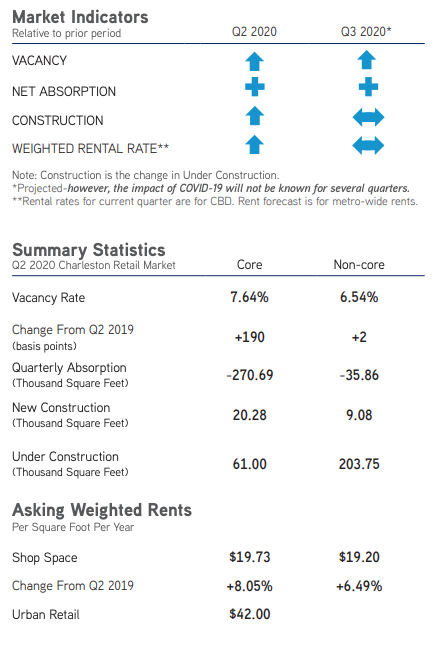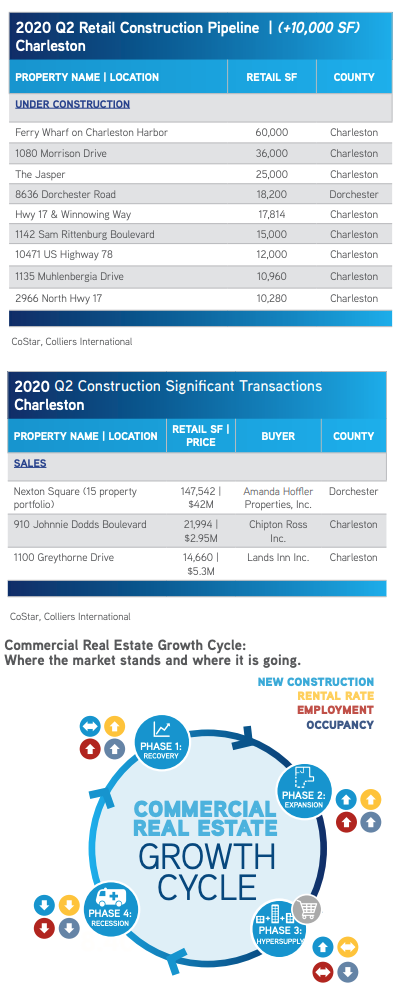Colliers Report: COVID-19 accelerates evolution of Charleston retail market
August 6, 2020
Research & Forecast Report
Q2-2020 CHARLESTON | RETAIL
Key Takeaways
- Many retailers closed their doors this quarter, however, some had been struggling prior to the COVID-19 loss of business.
- Absorption is usually composed of both negative and positive activity; however, this quarter tenants either remained in their space or closed their business and did not move to another space causing 306,546 square feet of negative absorption.
- Retailers are altering their shops and restaurants in order to provide a safe environment and positive experience for all consumers.
For additional commercial real estate news, check out our market reports here.
Providing new options for customers
 In an attempt to continue conducting business throughout the pandemic, many restaurants now have opened for indoor business, but with only half of the tables available for seating to customers. In addition, parking lots are often partially blocked off to accommodate outdoor seating. Online platforms have been updated for ease of use and walk-up or drive-thru options have been implemented in order to enhance productiveness.
In an attempt to continue conducting business throughout the pandemic, many restaurants now have opened for indoor business, but with only half of the tables available for seating to customers. In addition, parking lots are often partially blocked off to accommodate outdoor seating. Online platforms have been updated for ease of use and walk-up or drive-thru options have been implemented in order to enhance productiveness.
Retailers are spacing out their indoor merchandise and having sidewalk sales so customers are able to shop in person. However, fitting rooms are mostly unavailable, but return policies have been relaxed in order to raise the customer comfort level of “buying before trying.” Businesses are also limiting the number of shoppers at a given time, setting up sanitizing stations and reinforcing mandatory masks upon entering the establishment in order to provide a safe environment and positive experience for all shoppers.
Market Conditions
The Charleston retail market consists of approximately 14.42 million square feet of retail space and posted a negative absorption of 306,546 square feet during the second quarter of 2020. Over half of the negative absorption occurred in the West Ashley submarket. Non-core posted negative 270,685 square feet while core retail space posted negative 35,861 square feet. The amount of absorption is usually comprised of negative and positive activity; however, this quarter tenants either remained in their space or closed their business and did not move to another space. Therefore, there was a lot of negative absorption this quarter forcing the overall quarterly vacancy rate to increase sharply from 4.80% last quarter to 7.12% during the second quarter of 2020. Likewise, urban retail vacancies also increased to 4.04%.
According to Costar, there are currently 264,754 square feet of shopping center space under construction throughout the Charleston market; however, due to COVID-19 and rising vacancy rates there may be temporary delays or altered plans in the next few quarters. No retail buildings completed construction this quarter in the Charleston market. The overall average rental rate for the remaining shop space availabilities ranged from $10.68 per square foot in the Berkeley non-core submarket to $43.00 per square foot within the Calhoun to Crosstown urban retail submarket. Average rental rates in both core and non-core spaces are higher than they were during the second quarter of 2019.
Several retailers in the Charleston market closed their doors this quarter, but many had been struggling prior to the COVID-19 loss of business. Construction activity will likely stall until more of the existing vacancies are filled.
Conversely, new vacancies will provide retailers an opportunity to evaluate their current space and upgrade their real estate. Retail spaces that will be especially popular are those which provide ease of access, and option of curbside pickup. These shops will afford the tenant more control over their space such as being able to limit the amount of customers through their doors, setting up sanitizing stations outside of the entrance and allowing outdoor shopping and/or dining where space permits.
Retailers, as well as consumers, are learning to cope with new regulations and as everyone becomes more comfortable with the safety precautions throughout retail shops, the consumer traffic may pick up. While there are predicted to be many changes occurring within the retail sector, the true effects of the Coronavirus will not be evident for several quarters.
A Note Regarding COVID-19
As we publish this report, the U.S. and the world at large are facing a tremendous challenge, the scale of which is unprecedented in recent history. The spread of the novel Coronavirus (COVID-19) is significantly altering day-to-day life, impacting society, the economy and, by extension, commercial real estate.
The extent, length and severity of this pandemic is unknown and continues to evolve at a rapid pace. The scale of the impact and its timing varies between locations. To better understand trends and emerging adjustments, please subscribe to Colliers’ COVID-19 Knowledge Leader page for resources and recent updates.
For additional commercial real estate news, check out our market reports here.















